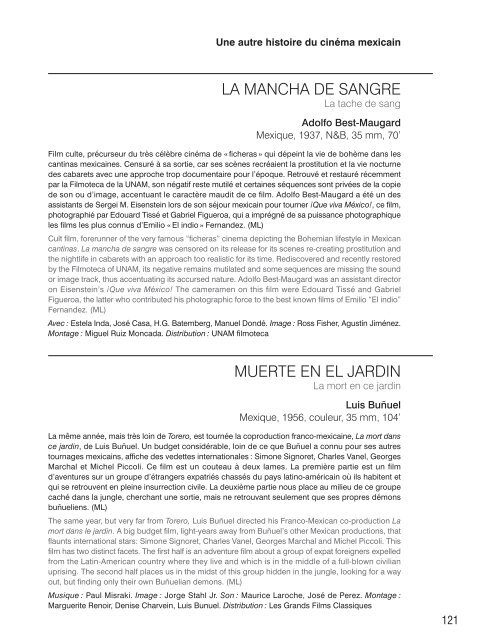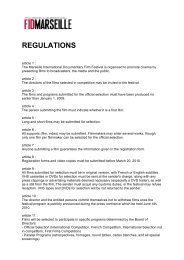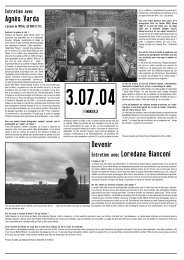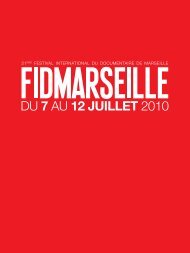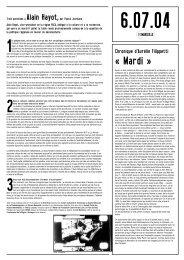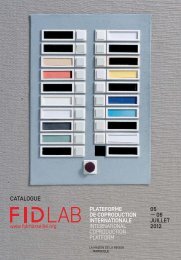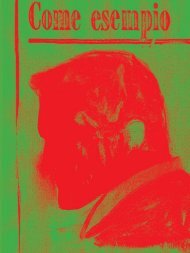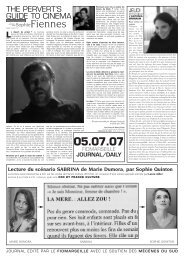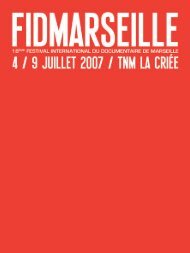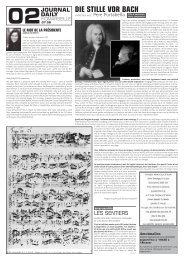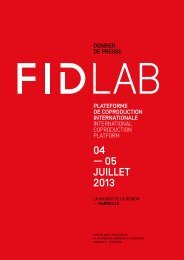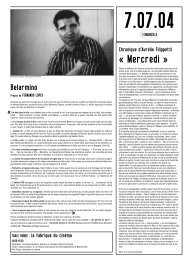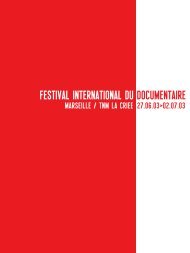FID Marseille 2011 - Festival international du documentaire de ...
FID Marseille 2011 - Festival international du documentaire de ...
FID Marseille 2011 - Festival international du documentaire de ...
You also want an ePaper? Increase the reach of your titles
YUMPU automatically turns print PDFs into web optimized ePapers that Google loves.
Une autre histoire <strong>du</strong> cinéma mexicainLA MANCHA DE SANGRELa tache <strong>de</strong> sangAdolfo Best-MaugardMexique, 1937, N&B, 35 mm, 70’Film culte, précurseur <strong>du</strong> très célèbre cinéma <strong>de</strong> « ficheras » qui dépeint la vie <strong>de</strong> bohème dans lescantinas mexicaines. Censuré à sa sortie, car ses scènes recréaient la prostitution et la vie nocturne<strong>de</strong>s cabarets avec une approche trop <strong>documentaire</strong> pour l’époque. Retrouvé et restauré récemmentpar la Filmoteca <strong>de</strong> la UNAM, son négatif reste mutilé et certaines séquences sont privées <strong>de</strong> la copie<strong>de</strong> son ou d’image, accentuant le caractère maudit <strong>de</strong> ce film. Adolfo Best-Maugard a été un <strong>de</strong>sassistants <strong>de</strong> Sergei M. Eisenstein lors <strong>de</strong> son séjour mexicain pour tourner ¡Que viva México!, ce film,photographié par Edouard Tissé et Gabriel Figueroa, qui a imprégné <strong>de</strong> sa puissance photographiqueles films les plus connus d’Emilio « El indio » Fernan<strong>de</strong>z. (ML)Cult film, forerunner of the very famous “ficheras” cinema <strong>de</strong>picting the Bohemian lifestyle in Mexicancantinas. La mancha <strong>de</strong> sangre was censored on its release for its scenes re-creating prostitution andthe nightlife in cabarets with an approach too realistic for its time. Rediscovered and recently restoredby the Filmoteca of UNAM, its negative remains mutilated and some sequences are missing the soundor image track, thus accentuating its accursed nature. Adolfo Best-Maugard was an assistant directoron Eisenstein’s ¡Que viva México! The cameramen on this film were Edouard Tissé and GabrielFigueroa, the latter who contributed his photographic force to the best known films of Emilio “El indio”Fernan<strong>de</strong>z. (ML)Avec : Estela Inda, José Casa, H.G. Batemberg, Manuel Dondé. Image : Ross Fisher, Agustín Jiménez.Montage : Miguel Ruiz Moncada. Distribution : UNAM filmotecaMUERTE EN EL JARDINLa mort en ce jardinLuis BuñuelMexique, 1956, couleur, 35 mm, 104’La même année, mais très loin <strong>de</strong> Torero, est tournée la copro<strong>du</strong>ction franco-mexicaine, La mort dansce jardin, <strong>de</strong> Luis Buñuel. Un budget considérable, loin <strong>de</strong> ce que Buñuel a connu pour ses autrestournages mexicains, affiche <strong>de</strong>s ve<strong>de</strong>ttes <strong>international</strong>es : Simone Signoret, Charles Vanel, GeorgesMarchal et Michel Piccoli. Ce film est un couteau à <strong>de</strong>ux lames. La première partie est un filmd’aventures sur un groupe d’étrangers expatriés chassés <strong>du</strong> pays latino-américain où ils habitent etqui se retrouvent en pleine insurrection civile. La <strong>de</strong>uxième partie nous place au milieu <strong>de</strong> ce groupecaché dans la jungle, cherchant une sortie, mais ne retrouvant seulement que ses propres démonsbuñueliens. (ML)The same year, but very far from Torero, Luis Buñuel directed his Franco-Mexican co-pro<strong>du</strong>ction Lamort dans le jardin. A big budget film, light-years away from Buñuel’s other Mexican pro<strong>du</strong>ctions, thatflaunts <strong>international</strong> stars: Simone Signoret, Charles Vanel, Georges Marchal and Michel Piccoli. Thisfilm has two distinct facets. The first half is an adventure film about a group of expat foreigners expelledfrom the Latin-American country where they live and which is in the middle of a full-blown civilianuprising. The second half places us in the midst of this group hid<strong>de</strong>n in the jungle, looking for a wayout, but finding only their own Buñuelian <strong>de</strong>mons. (ML)Musique : Paul Misraki. Image : Jorge Stahl Jr. Son : Maurice Laroche, José <strong>de</strong> Perez. Montage :Marguerite Renoir, Denise Charvein, Luis Bunuel. Distribution : Les Grands Films Classiques121


